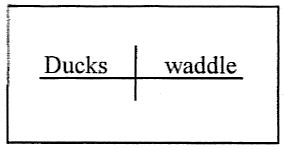You wouldn't think it would be hard to define "subject of a sentence," but it is. For starters, let's just say a subject is a noun or a pronoun about which a sentence says something. What about "predicate"? What could that be? Well, that's the verb together with its modifiers and complements. Briefly, modifiers of verbs are adverbs or adverbial expressions while complements are such things as predicate nominatives and direct objects.
A noun is the name of anything; woman, student, country, darkness, lion, curiosity, and Mr. Jones are all nouns. A verb is a word that expresses action or state. Most verbs end in s in the he/she/it-forms of the present tense, most have an -ing form, and most have a simple past that differs from the present tense.
As you make your way through these flashcards, you may wish to refer to a section of my website that deals with terminology, www.german-latin-english.com/diagrammingterms.htm. For instance, if you are eager to know what pronouns are, or adverbs, or, say, direct objects, you'll find the answer there.

**Alonzo Reed and Brainerd Kellogg (A Work of English Grammar and Composition, 1877) modified and popularized a system of diagramming introduced by Stephen Clark in 1863. The Reed & Kellogg system of diagramming, expanded by Homer C. House and Susan Emolyn Harman (Descriptive English Grammar, 1950) is still used today.
ERM